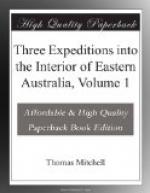FISHES.
The species of fish most abundant in the Darling is the Gristes peelii, or cod-perch, and they are caught of a very large size by the natives. We also saw the thick-scaled mud-tasted fish (Cernua bidyana, see above). We did not on this occasion see that very remarkable fish, the Eel-fish (Plotosus tandanus) so abundant in the higher parts of the river. The water was too clear and the weather too cold for fishing with bait, one of each of the two species first mentioned caught during our first occupation of Fort Bourke, being all we ever procured.
APPREHENDED SCARCITY OF WATER ON LEAVING THE DARLING.
No rain had fallen during the four months which had elapsed since we left the colony, and it was probable that the ponds of the Bogan, many of which our cattle had drunk up during our advance, would not afford a sufficient supply of water, nor even be numerous enough on the route for our daily wants, considering the short stages we were obliged to travel on account of the exhausted cattle.
SIX OF THE CATTLE DEAD FROM EXHAUSTION.
We had already lost six bullocks on our return journey, some having got bogged, and others having lain down from weakness, never to rise. For three hundred miles we were now to depend on the ponds of the Bogan, and again to contend with the scarcity of water, a disadvantage from which we had been quite free while on the banks of the Darling.
REST OF TWO DAYS AT FORT BOURKE.
August 11.
Having at length two days of leisure, I was anxious to complete my surveys of this river. I found that the distance from D’Urban’s group to Mr. Hume’s tree, the furthest point attained by Captain Sturt, was 17 miles and 22 chains, not 33 miles as stated by that traveller; and that the highest summit of D’Urban’s group bore from it 53 degrees East of South not 58 degrees East of South, the latter bearing, as given by Sturt, being probably a clerical or typographical error.




